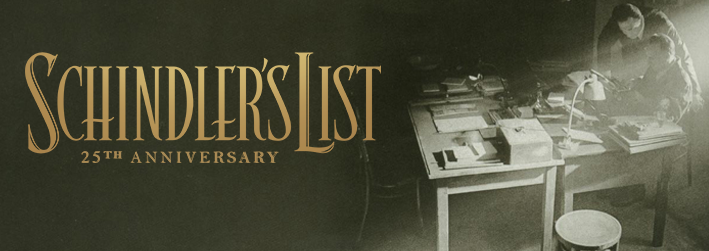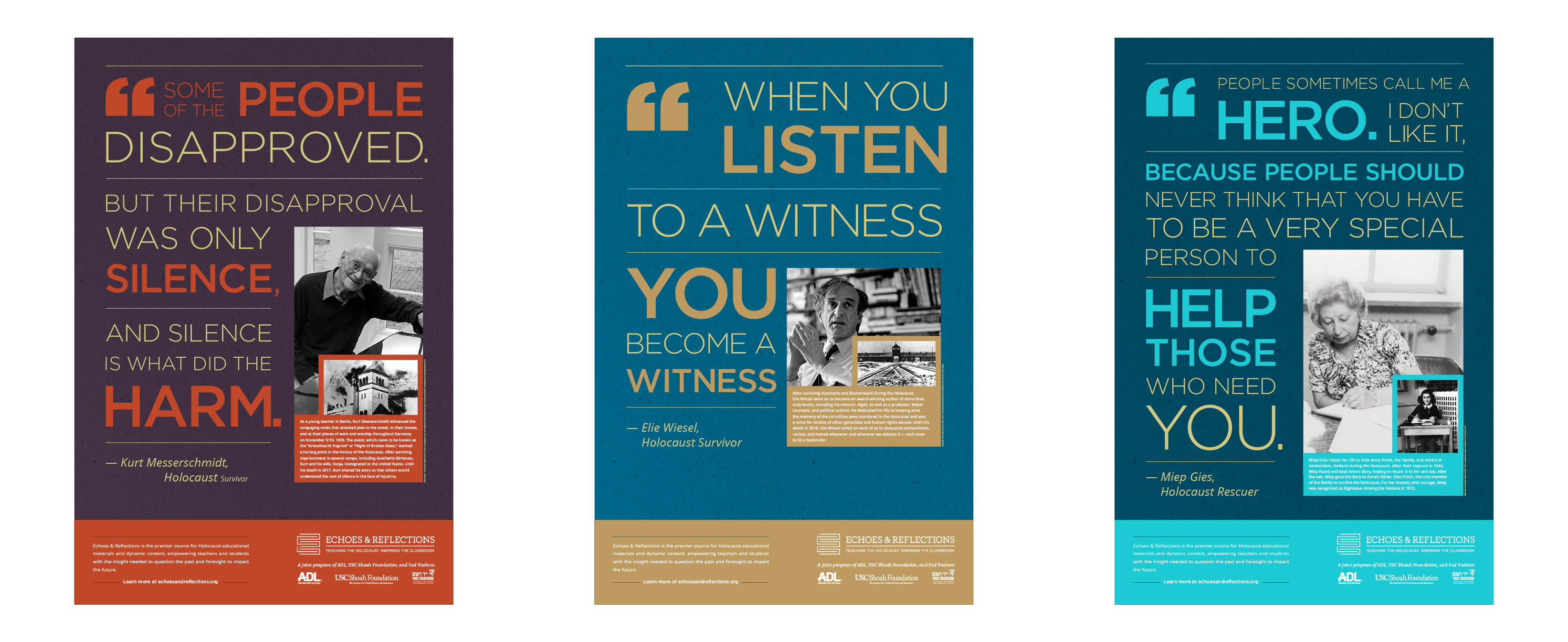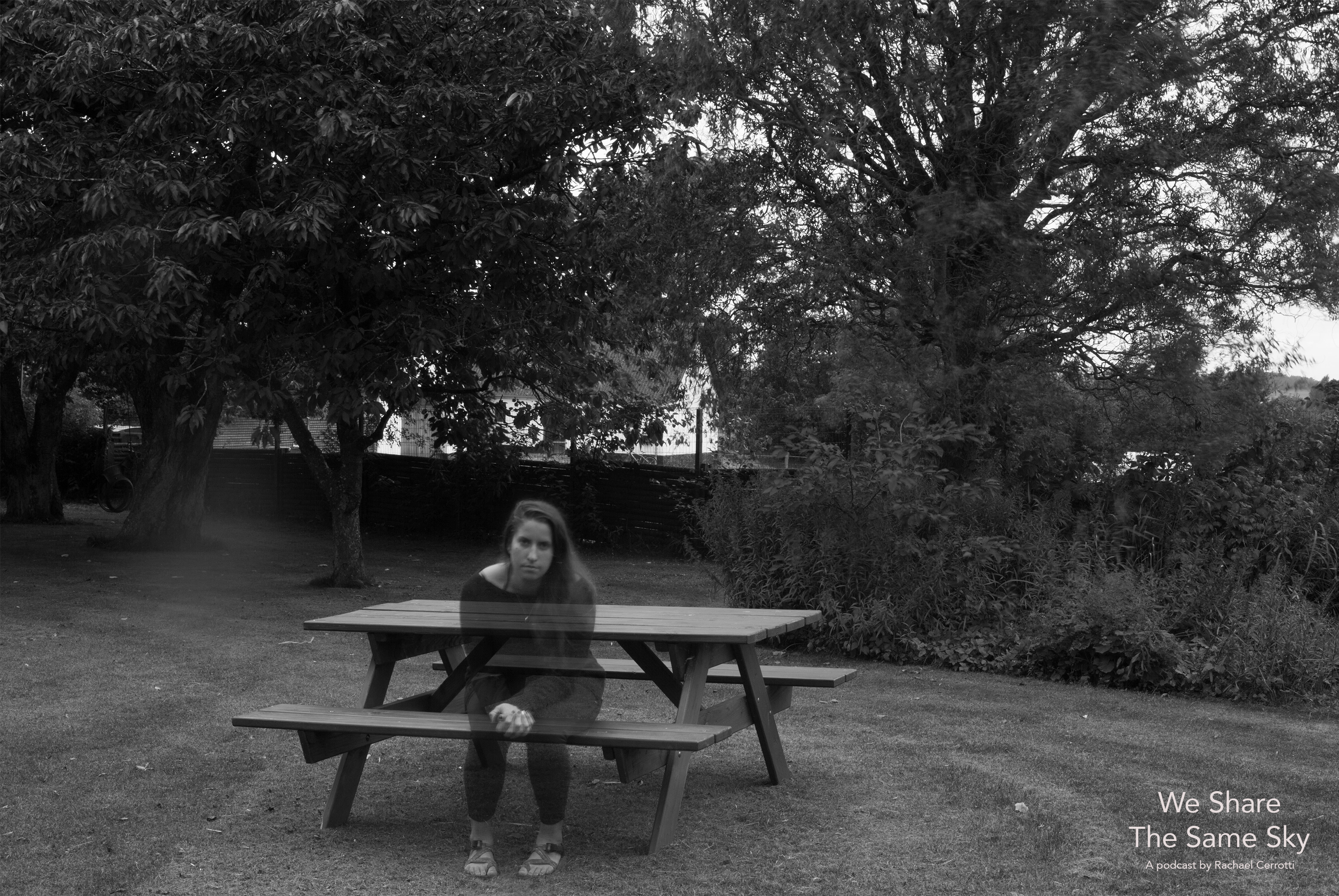TEACH
![]()
LESSON PLAN
EDUCATOR RESOURCE: LESSON PLANS
Our Lesson Plans provide a unique experience for educators to teach about the Holocaust effectively and interactively. The modular design of the lessons found within each unit allow for adaption and customization to specific grade levels and subject areas. The integration of rich content helps students construct an authentic and comprehensive portrait of the past as they frame their own thoughts about what they are learning, resulting in a deeper level of interest and inquiry. Each lesson includes:
- Step-by-step procedures
- Estimated completion time
- Resources labeled by icons






 direct teachers to the piece of content named in the procedures
direct teachers to the piece of content named in the procedures
- Print-ready pages as indicated by
 are available as PDFs for download
are available as PDFs for download
If you are new to teaching about the Holocaust, we encourage you to participate in one of our
online course offerings to support instruction ahead. As well, for teachers with limited instructional time seeking a starting point, we offer a sample
One Day Lesson Plan, as well as a sample
Day Two Lesson Plan for a 2nd class period of instruction.
For more information, questions or concerns please
contact us.
PEDAGOGY PRINCIPLES FOR EFFECTIVE HOLOCAUST INSTRUCTION
PEDAGOGICAL PRINCIPLES FOR EFFECTIVE HOLOCAUST INSTRUCTION

December 2018 marks the 25th anniversary of the release of Steven Spielberg’s Schindler’s List, which depicts the true story of Oskar Schindler—a man who saved the lives of more than 1,200 Jews during the Holocaust. It was Spielberg’s experience making this film that inspired him to collect and preserve the testimonies of over 54,000 Holocaust survivors and witnesses, a pursuit which ultimately led to the creation of what is now USC Shoah Foundation.
In honor of Universal Pictures’ rerelease of Schindler’s List, Echoes & Reflections has created a short, classroom-ready Companion Resource, that will help educators to provide important historical background and context to the film, as well as explore powerful true stories of rescue, survival, and resilience with their students.
Additionally, the following videos, recorded at Yad Vashem, feature Schindler survivors who speak of the impact Oskar Schindler had on their lives.
EVA LAVI TESTIMONY
Eva Lavi was the youngest survivor from Schindler’s list. She was two years old when the war began.
NAHUM & GENIA MANOR
Nahum Manor met and fell in love with his wife, Genia, in Schindler’s factory. Watch him read a letter at
Schindler’s gravesite, expressing what he meant to them.
CLASSROOM POSTER SERIES
INSPIRING THE HUMAN STORY
Echoes & Reflections is excited to announce that our poster series:
Inspiring the Human Story, is now available in PDF format,
free of cost.
The posters feature the powerful words and experiences of Holocaust survivor and memoirist
Elie Wiesel, Holocaust survivor
Kurt Messerschmidt, and Anne Frank rescuer,
Miep Gies. Each poster promotes meaningful conversation and reflection in the classroom, whether in person or in a virtual setting, and inspires students with powerful human stories of the Holocaust that can continue to guide agency and action as a result of studying this topic.
To support you in these efforts, we have also compiled several suggested
classroom activities from teachers in our network that may be of use and interest.

Please fill out the form below to access and download your PDF posters.
WE SHARE THE SAME SKY
USC Shoah Foundation’s first podcast, We Share The Same Sky, seeks to brings the past into present through a granddaughter’s decade-long journey to retrace her grandmother’s story of survival. We Share The Same Sky tells the two stories of these women—the grandmother, Hana, a refugee who remained one step ahead of the Nazis at every turn, and the granddaughter, Rachael, on a search to retrace her grandmother’s history.
 A self-portrait of Rachael while she is living on a Danish farm that is owned by the granddaughter of Hana’s foster mother from World War II. Photo by Rachael Cerrotti, 2017
A self-portrait of Rachael while she is living on a Danish farm that is owned by the granddaughter of Hana’s foster mother from World War II. Photo by Rachael Cerrotti, 2017
In order to enhance its classroom use, USC Shoah Foundation and Echoes & Reflections have created a Companion Educational Resource to support teachers as they introduce the podcast to their students. This document provides essential questions for students, as well as additional resources and content to help build context and framing for students’ understanding of the historical events addressed in the podcast.
Access to the podcast, as well as additional supporting materials—including IWitness student activities, academic standards alignment, and general strategies for teaching with podcasts—can all be found at the We Share The Same Sky page in IWitness.
Note: Due to the subject nature, the podcast is appropriate for older students, grades 10-12. As always, teachers should review the content fully in advance to determine its appropriateness for their student population.

 After many years of research and digitizing the archive her grandmother left behind, Rachael set out to retrace her grandmother’s 17 years of statelessness. Her intention was to travel via the same modes of transportation and to live similar style lives as to what her grandmother did during the war and in the years after. That meant that when she got to Denmark, she moved to a farm. Rachael moved in with the granddaughter of her grandmother’s foster mother from World War II and traded her labor for room and board as Hana once did. This picture is from that first visit in the winter of 2015. Since this time, Rachael has spent many more months living on this farm. It is owned by Sine Christiansen and her family. Sine is the granddaughter of Jensine, one Hana’s foster mother from World War II. Photo by Rachael Cerrotti, 2015
After many years of research and digitizing the archive her grandmother left behind, Rachael set out to retrace her grandmother’s 17 years of statelessness. Her intention was to travel via the same modes of transportation and to live similar style lives as to what her grandmother did during the war and in the years after. That meant that when she got to Denmark, she moved to a farm. Rachael moved in with the granddaughter of her grandmother’s foster mother from World War II and traded her labor for room and board as Hana once did. This picture is from that first visit in the winter of 2015. Since this time, Rachael has spent many more months living on this farm. It is owned by Sine Christiansen and her family. Sine is the granddaughter of Jensine, one Hana’s foster mother from World War II. Photo by Rachael Cerrotti, 2015
 A self portrait of Rachael overlooking the exact spot in Southern Sweden where her grandmother’s refugee boat came to shore in 1943. Photo by Rachael Cerrotti, 2016
A self portrait of Rachael overlooking the exact spot in Southern Sweden where her grandmother’s refugee boat came to shore in 1943. Photo by Rachael Cerrotti, 2016


![]() ESTIMATED COMPLETION TIME
ESTIMATED COMPLETION TIME120 minutes
LESSON 2: Nazi Antisemitic Ideology and Propaganda
Introduction 
In this lesson, students define ideology and propaganda and explore the ways in which Nazi ideology both reflected historic antisemitism and created new forms of antisemitic hate. Students investigate primary and secondary source material about Nazi ideology and analyze visual examples of Nazi propaganda to deepen their understanding of how these techniques were deployed. Students view visual history testimonies to learn about the personal impact of propaganda.
Post the supporting question above for students as you begin this part of the lesson.
| 1 | The handout, How are Ideology and Propaganda Related?, is distributed. The class reviews the definitions of ideology and propaganda together. In pairs or small groups, students complete the handout, listing examples and exploring the relationship between the two concepts. The class then reconvenes to review their conclusions. The idea that propaganda is a vehicle for disseminating ideology is emphasized, and the following characteristics of propaganda are shared to help students understand how it influences members of a society.
|
 STUDENT HANDOUTHow are Ideology and Propaganda Related? View More »
STUDENT HANDOUTHow are Ideology and Propaganda Related? View More »
Repeats the same information over and over
Gives the illusion that most people agree with the message
Often twists and exploits the truth
|
Talks to people in their own language
Appeals to people’s emotions
Uses accessible media (e.g., newspaper, radio, social media)
|
| 2 | Students remain in their groups and examine the map, Jewish Communities Before the Nazis Rise to Power. They chart their observations as illustrated below, or by using the handout Jewish Communities Map Analysis.

|
MAP: Jewish Communities Before the Nazis Rise to PowerView More »
 STUDENT HANDOUTJewish Communities Map Analysis View More »
STUDENT HANDOUTJewish Communities Map Analysis View More »
| 3 | The class reconvenes and discusses the inferences they made as well as any outstanding questions. The following ideas are highlighted:
|
Jewish people represented a very small percentage of the population in European countries – the odds were that most people in those countries had never met a Jew.
It’s easier to believe propaganda about people with whom you have limited or no experience.
|
The Nazis used propaganda to incite antisemitism so that even people who would have had no reason to hate Jewish people began to believe the poisonous ideas about them.
Even people who should have known better – like H. Henry’s friends and Margaret’s teammates – were influenced by the stereotypes and false ideas spread by the Nazis.
|
| 4 | Students continue to investigate the nature of Nazi ideology and propaganda by consulting at least two of the sources below. In small groups, they record examples of ideology and propaganda, and consider how the Nazis made use of historical antisemitism and also created new forms of antisemitism.
SOURCES
OPTIONAL: Students can also revisit the final section of the Summary of Antisemitism handout from the previous lesson.
|
| 5 | In their groups or as a whole class, students discuss the following questions:
|
How did Hitler’s writings reflect previous antisemitic stereotypes? What new ideas appear in his writings?
How did Nazi ideology build on older and well-known antisemitic stereotypes and religious hatred from the past? Why might the Nazis have done this, and why might this have been particularly effective?
|
|
| 6 | Students watch testimony clips of two individuals who convey how Nazi ideology and propaganda manifested in Germany and affected their lives: [L]Judith Becker[/L] and [L]H. Henry Sinason[/L] As they watch the clips, students take notes on the Testimony Reflections handout, found at the beginning of this unit, and continue to note examples of ideology and propaganda.
|
| 7 | After viewing the testimony clips, students journal and/or participate in a whole group discussion in response to some of the following questions:
|
Why did the Nazis form the Hitler Youth and target young people with their ideology? Why were many youth receptive to these messages? What pressures might those who resisted these messages have faced?
What does the story Judith Becker shares reveal about Nazi ideology?
|
What is your reaction to the principal in Judith’s story, who is personally supportive of Felix but ultimately asks him to leave the school? What pressures did he face? What choices did he have in this situation?
How did Nazi ideology and propaganda affect H. Henry Sinason? How did these forces creep into and invade the everyday lives of Jewish people?
|
Post the supporting question above for students as you begin this part of the lesson.
| 8 | Six examples of Nazi propaganda are displayed around the room. Individually or in pairs, students take a “gallery walk” and visit each example for a short amount of time (images can be viewed in any order). At each station, students chart their answers to the questions below on paper or by using the handout, Nazi Propaganda Analysis.

|
| 9 | After completing the gallery walk, students stand near one image that they found to be a particularly effective example of propaganda’s ability to manipulate others. They write why they chose that image on a sticky note and place it near the image. The group that has gathered at each image talks about their responses. The class discusses some of the following questions as time allows.
|
Do you think people were able to recognize this propaganda as false? Among those who did, what might they have been thinking and feeling at the time?
How did the propaganda and stereotypes used by the Nazis dehumanize Jews? What might have been the effects of such dehumanization for both individuals and Jewish communities in Germany?
|
|
| 10 | Students watch a testimony clip of an individual who shares how she was affected by Nazi propaganda: [L]Esther Clifford[/L] . As they watch the clip, students take notes on the Testimony Reflections handout, found at the beginning of this unit. After viewing, they discuss the following:
|
What were some of the visual images that Esther Clifford talks about seeing on her way to school? What aspects of Nazi ideology did they reflect?
What effect did seeing this propaganda have on Esther? How did it make her feel to see members of her community engaging with it?
|
Thinking back to the testimonies of H. Henry and Henry, how were they impacted by propaganda spreading in their communities?
Esther comments that “By the time I got to school, I couldn’t learn.” What examples of prejudice are you aware of today that might prevent students from learning in school?
|
| 11 | As a summative task, students create or use the handout, “3 x 3” journal, addressing the unit essential question, “How do ideologies circulate within societies and influence individuals and groups?” The journal is a grid that includes three facets of Nazi ideology in the first column, and examples of propaganda used to disseminate it in the other columns. As an extra challenge, students can be asked to include at least one example of ideology that exploited historical antisemitism and one that represented a new idea. Students should include evidence from lesson sources to support their ideas. The journal can be adapted to be shorter (“2 x 2”) or longer (“4 x 4”) depending on time available and student needs.
|
Making Connections

The ideas below are offered as ways to extend the lessons in this unit and make connections to related historical events, current issues, and students’ own experiences. These topics can be integrated directly into Echoes & Reflections lessons, used as stand-alone teaching ideas, or investigated by students engaged in project-based learning.
View More +
| 1 | Developing students’ media literacy skills is a crucial component in today’s world. Check out this student self-directed activity, Using Media Literacy Skills to Examine the Holocaust, and assign to your students to foster this skill alongside furthering their understanding of the impact of propaganda on individuals in a society.
|
| 2 | Visit IWitness (iwitness.usc.edu) to access additional testimonies, resources, and learning activities about pre-war Jewish life, propaganda, and antisemitism in Europe.
|
| 3 | Many people thought that after the Holocaust, antisemitism would disappear. Complete a research project that explores why this form of hate has persisted. Work in small groups to develop a written, oral, or visual presentation. Consult the Anti-Defamation League (https://www.adl.org) and Southern Poverty Law Center (https://www.splcenter.org) websites among other sources. Some of the following questions should guide the research:
|
What organized groups use antisemitism to advance their goals?
How have these groups made use of Nazi ideology?
What other groups of people do these hate groups target?
What activities of these hate groups are banned by law? What activities are legal?
|
Who joins hate groups? How are young people lured into joining hate groups?
What role does the Internet play in spreading the message of hate groups?
What recent events have served to increase the intensity and broaden the scope of modern antisemitism?
|
| 4 | Organize a debate as follows: One group argues that the United States government should prohibit the activities of groups and individuals that promote hatred, as in Germany, where the dissemination of racist and antisemitic material is illegal; the other group argues that the First Amendment must be upheld, which includes the freedom of expression for groups that promote hate.
|
| 5 | The antisemitic children’s book, The Poisonous Mushroom (Der Giftpilz in German), was written by Ernst Hiemer and published by Julius Streicher, who also published the antisemitic newspaper, Der Stürmer. Gather information from multiple print and digital sources about how children’s books like The Poisonous Mushroom were used to promote Nazi ideology. Prepare a presentation using PowerPoint or another multimedia tool. Presentations should include examples of children’s books published during the period, information about how people responded to the books, if possible, as well as your interpretations of the books and what was learned about propaganda from studying them.
|
| 6 | Answer the following question in an explanatory text or a multimedia presentation: How are we influenced by propaganda in our lives and how can we protect ourselves from harmful propaganda? First, identify examples of propaganda, for example through advertising, social media influencers, or political ads and campaigns. After describing the examples gathered, analyze the techniques that are being used to influence people and what impact they might have. Conclude with ideas about safeguards that might be employed to protect people from any negative influences.
|
Close -
 ESTIMATED COMPLETION TIME
ESTIMATED COMPLETION TIME120 minutes
LESSON 2: Nazi Antisemitic Ideology and Propaganda
Introduction 
In this lesson, students define ideology and propaganda and explore the ways in which Nazi ideology both reflected historic antisemitism and created new forms of antisemitic hate. Students investigate primary and secondary source material about Nazi ideology and analyze visual examples of Nazi propaganda to deepen their understanding of how these techniques were deployed. Students view visual history testimonies to learn about the personal impact of propaganda.
Post the supporting question above for students as you begin this part of the lesson.
| 1 | The handout, How are Ideology and Propaganda Related?, is distributed. The class reviews the definitions of ideology and propaganda together. In pairs or small groups, students complete the handout, listing examples and exploring the relationship between the two concepts. The class then reconvenes to review their conclusions. The idea that propaganda is a vehicle for disseminating ideology is emphasized, and the following characteristics of propaganda are shared to help students understand how it influences members of a society.
|
 STUDENT HANDOUTHow are Ideology and Propaganda Related? View More »
STUDENT HANDOUTHow are Ideology and Propaganda Related? View More »
Repeats the same information over and over
Gives the illusion that most people agree with the message
Often twists and exploits the truth
|
Talks to people in their own language
Appeals to people’s emotions
Uses accessible media (e.g., newspaper, radio, social media)
|
| 2 | Students remain in their groups and examine the map, Jewish Communities Before the Nazis Rise to Power. They chart their observations as illustrated below, or by using the handout Jewish Communities Map Analysis.

|
 MAP: Jewish Communities Before the Nazis Rise to PowerView More »
MAP: Jewish Communities Before the Nazis Rise to PowerView More »
 STUDENT HANDOUTJewish Communities Map Analysis View More »
STUDENT HANDOUTJewish Communities Map Analysis View More »
| 3 | The class reconvenes and discusses the inferences they made as well as any outstanding questions. The following ideas are highlighted:
|
Jewish people represented a very small percentage of the population in European countries – the odds were that most people in those countries had never met a Jew.
It’s easier to believe propaganda about people with whom you have limited or no experience.
|
The Nazis used propaganda to incite antisemitism so that even people who would have had no reason to hate Jewish people began to believe the poisonous ideas about them.
Even people who should have known better – like H. Henry’s friends and Margaret’s teammates – were influenced by the stereotypes and false ideas spread by the Nazis.
|
| 4 | Students continue to investigate the nature of Nazi ideology and propaganda by consulting at least two of the sources below. In small groups, they record examples of ideology and propaganda, and consider how the Nazis made use of historical antisemitism and also created new forms of antisemitism.
SOURCES
OPTIONAL: Students can also revisit the final section of the Summary of Antisemitism handout from the previous lesson.
|
| 5 | In their groups or as a whole class, students discuss the following questions:
|
How did Hitler’s writings reflect previous antisemitic stereotypes? What new ideas appear in his writings?
How did Nazi ideology build on older and well-known antisemitic stereotypes and religious hatred from the past? Why might the Nazis have done this, and why might this have been particularly effective?
|
|
| 6 | Students watch testimony clips of two individuals who convey how Nazi ideology and propaganda manifested in Germany and affected their lives: [L]Judith Becker[/L] and [L]H. Henry Sinason[/L] As they watch the clips, students take notes on the Testimony Reflections handout, found at the beginning of this unit, and continue to note examples of ideology and propaganda.
|
| 7 | After viewing the testimony clips, students journal and/or participate in a whole group discussion in response to some of the following questions:
|
Why did the Nazis form the Hitler Youth and target young people with their ideology? Why were many youth receptive to these messages? What pressures might those who resisted these messages have faced?
What does the story Judith Becker shares reveal about Nazi ideology?
|
What is your reaction to the principal in Judith’s story, who is personally supportive of Felix but ultimately asks him to leave the school? What pressures did he face? What choices did he have in this situation?
How did Nazi ideology and propaganda affect H. Henry Sinason? How did these forces creep into and invade the everyday lives of Jewish people?
|
Post the supporting question above for students as you begin this part of the lesson.
| 8 | Six examples of Nazi propaganda are displayed around the room. Individually or in pairs, students take a “gallery walk” and visit each example for a short amount of time (images can be viewed in any order). At each station, students chart their answers to the questions below on paper or by using the handout, Nazi Propaganda Analysis.

|
| 9 | After completing the gallery walk, students stand near one image that they found to be a particularly effective example of propaganda’s ability to manipulate others. They write why they chose that image on a sticky note and place it near the image. The group that has gathered at each image talks about their responses. The class discusses some of the following questions as time allows.
|
Do you think people were able to recognize this propaganda as false? Among those who did, what might they have been thinking and feeling at the time?
How did the propaganda and stereotypes used by the Nazis dehumanize Jews? What might have been the effects of such dehumanization for both individuals and Jewish communities in Germany?
|
|
| 10 | Students watch a testimony clip of an individual who shares how she was affected by Nazi propaganda: [L]Esther Clifford[/L] . As they watch the clip, students take notes on the Testimony Reflections handout, found at the beginning of this unit. After viewing, they discuss the following:
|
What were some of the visual images that Esther Clifford talks about seeing on her way to school? What aspects of Nazi ideology did they reflect?
What effect did seeing this propaganda have on Esther? How did it make her feel to see members of her community engaging with it?
|
Thinking back to the testimonies of H. Henry and Henry, how were they impacted by propaganda spreading in their communities?
Esther comments that “By the time I got to school, I couldn’t learn.” What examples of prejudice are you aware of today that might prevent students from learning in school?
|
| 11 | As a summative task, students create or use the handout, “3 x 3” journal, addressing the unit essential question, “How do ideologies circulate within societies and influence individuals and groups?” The journal is a grid that includes three facets of Nazi ideology in the first column, and examples of propaganda used to disseminate it in the other columns. As an extra challenge, students can be asked to include at least one example of ideology that exploited historical antisemitism and one that represented a new idea. Students should include evidence from lesson sources to support their ideas. The journal can be adapted to be shorter (“2 x 2”) or longer (“4 x 4”) depending on time available and student needs.
|
Making Connections

The ideas below are offered as ways to extend the lessons in this unit and make connections to related historical events, current issues, and students’ own experiences. These topics can be integrated directly into Echoes & Reflections lessons, used as stand-alone teaching ideas, or investigated by students engaged in project-based learning.
View More +
| 1 | Developing students’ media literacy skills is a crucial component in today’s world. Check out this student self-directed activity, Using Media Literacy Skills to Examine the Holocaust, and assign to your students to foster this skill alongside furthering their understanding of the impact of propaganda on individuals in a society.
|
| 2 | Visit IWitness (iwitness.usc.edu) to access additional testimonies, resources, and learning activities about pre-war Jewish life, propaganda, and antisemitism in Europe.
|
| 3 | Many people thought that after the Holocaust, antisemitism would disappear. Complete a research project that explores why this form of hate has persisted. Work in small groups to develop a written, oral, or visual presentation. Consult the Anti-Defamation League (https://www.adl.org) and Southern Poverty Law Center (https://www.splcenter.org) websites among other sources. Some of the following questions should guide the research:
|
What organized groups use antisemitism to advance their goals?
How have these groups made use of Nazi ideology?
What other groups of people do these hate groups target?
What activities of these hate groups are banned by law? What activities are legal?
|
Who joins hate groups? How are young people lured into joining hate groups?
What role does the Internet play in spreading the message of hate groups?
What recent events have served to increase the intensity and broaden the scope of modern antisemitism?
|
| 4 | Organize a debate as follows: One group argues that the United States government should prohibit the activities of groups and individuals that promote hatred, as in Germany, where the dissemination of racist and antisemitic material is illegal; the other group argues that the First Amendment must be upheld, which includes the freedom of expression for groups that promote hate.
|
| 5 | The antisemitic children’s book, The Poisonous Mushroom (Der Giftpilz in German), was written by Ernst Hiemer and published by Julius Streicher, who also published the antisemitic newspaper, Der Stürmer. Gather information from multiple print and digital sources about how children’s books like The Poisonous Mushroom were used to promote Nazi ideology. Prepare a presentation using PowerPoint or another multimedia tool. Presentations should include examples of children’s books published during the period, information about how people responded to the books, if possible, as well as your interpretations of the books and what was learned about propaganda from studying them.
|
| 6 | Answer the following question in an explanatory text or a multimedia presentation: How are we influenced by propaganda in our lives and how can we protect ourselves from harmful propaganda? First, identify examples of propaganda, for example through advertising, social media influencers, or political ads and campaigns. After describing the examples gathered, analyze the techniques that are being used to influence people and what impact they might have. Conclude with ideas about safeguards that might be employed to protect people from any negative influences.
|






 direct teachers to the piece of content named in the procedures
direct teachers to the piece of content named in the procedures are available as PDFs for download
are available as PDFs for download






















